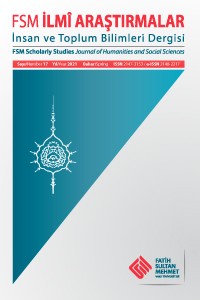Abstract
Bu çalışmada devrinin vakanüvisi Vasıf Efendi’nin, “İnsan-ı kâmil denilmeğe sezâ,
sadru’l-vüzerâ elkabına revâ” diye nitelendirdiği, ünlü bir devlet adamı olduğu kadar edebî
ve ilmî yeteneğiyle de maruf ve meşhur olan Koca Mehmed Râgıb Paşa’nın (1698/99-
1763), Beydâvî’nin Envâru’t-tenzîl ve esrâru’t-te’vîl isimli tefsirine yazdığı hâşiye irdelenmektedir.
Bu amaçla ilk olarak, muhaşşînin hayatından icmâlî olarak bahsedilmektedir.
Daha sonra mahtût bir eser olan bu Hâşiye hakkında şekil ve üslûp bakımından bazı bilgiler
verilmektedir. Çalışmada eser, metot ve muhteva yönünden de değerlendirilmektedir.
Bu çerçevede hâşiyede rivâyet ve dirâyet yöntemlerinin nasıl işlendiği somut örnekler
üzerinden tespit edilmeye çalışılmaktadır. Hâşiyenin esbab-ı nüzule yaklaşımı, israiliyat
konusundaki tavrı, i’câzu’l-Kur’ân hakkındaki beyanları, kıraatlere yönelik açıklamaları, sarf ve nahve dair izahları da işlenmektedir. Mühaşşi Koca Ragıb’ın yapmış olduğu fıkhî
ve kelâmî açıklamalar da bahse konu edilmektedir. Hâşiyede yararlanılan kaynaklar da
belirtilmektedir. Ayrıca bu makalede, eserin Osmanlının hâşiye kültürü içinde ne tür bir
kıymeti hâiz olduğu, alana nasıl bir katkı sağladığı ve yine birçok başarılı edebî ve tarihî
eserler ile adından sıklıkla söz ettiren Râgıb Paşa’nın, İslâmî ilimlerde de aynı derecede
behresi olup-olmadığı şeklindeki birtakım suallere cevaplar aranmaktadır.
Keywords
References
- Abay, Muhammed, “Osmanlı Döneminde Tefsir Haşiyeleri”, Başlangıçtan Günümüze Türklerin Kur’an Tefsirine Hizmetleri –Tebliğler ve Müzakereler-, İstanbul, Ensar Neşriyat, 2012.
- Afyoncu, Erhan, “Kalemden Kılıca: Koca Râgıb Paşa’nın Osmanlı Bürokrasisinde Yükselişi”, Journal of Turkish Studies Türklük Bilgileri Araştırtmaları Şinasi Tekin Hatıra Sayısı I, haz. Yücel Dağlı-Yorgos Dedes-Selim S. Kuru, Boston, Harvard Üniversitesi, 2007.
- Akpınar, Cemil, “İcâzet”, Türkiye Diyanet Vakfı İslam Ansiklopedisi, 21, İstanbul, Türkiye Diyanet Vakfı Yayınları, 2000.
Abstract
In this study, the annotation (hāshiya) of Koca Mehmed Rāgib Pasha (d.1698/99-
1763) to Baydāwī’s tafsīr book called Anwāru’t-tanzîl wa Asrāru’t -ta’wīl is analyzed.
Vasıf Efendi -who was a chronicler in his time- defined Koca Mehmed Rāgib Pasha -who
was literary scholarly talented and the famous statesman- as “İnsan-ı kâmil denilmeye
sezâ, sadru’l-vüzerâ elkabına revâ.” For this purpose, initially, the life of the annotator
(muhashshi) is mentioned generally. And then information about style and genre of the
annotation which is a written work is given. Also in this study the book is evaluated in
terms of method and content. Within this scope, how riwāyat and dirāyat methods were
used in this annotation is tried to be detected with concrete examples. The annotation’s
approaches to the reasons of the revelation (asbab al-nuzûl), the attitude about isrāiliyyāt,
the statements about İ’cāzu’l-Qur’ān, the explanations on qiraāt, the explications related
to sarf and nahw are handled. The fıqhī and kalāmī explanations which Koca Rāgib Pasha
made are mentioned too. The used references in the annotation are given. In this article,
the answers to the questions as how important the annotation culture is in the Ottoman,
how they contributed to this field and whether Koca Rāgib Pasha who is cited in the literary
and historical works often is successful as far as in the Islamic Sciences are searched.
Keywords
References
- Abay, Muhammed, “Osmanlı Döneminde Tefsir Haşiyeleri”, Başlangıçtan Günümüze Türklerin Kur’an Tefsirine Hizmetleri –Tebliğler ve Müzakereler-, İstanbul, Ensar Neşriyat, 2012.
- Afyoncu, Erhan, “Kalemden Kılıca: Koca Râgıb Paşa’nın Osmanlı Bürokrasisinde Yükselişi”, Journal of Turkish Studies Türklük Bilgileri Araştırtmaları Şinasi Tekin Hatıra Sayısı I, haz. Yücel Dağlı-Yorgos Dedes-Selim S. Kuru, Boston, Harvard Üniversitesi, 2007.
- Akpınar, Cemil, “İcâzet”, Türkiye Diyanet Vakfı İslam Ansiklopedisi, 21, İstanbul, Türkiye Diyanet Vakfı Yayınları, 2000.
Details
| Primary Language | Turkish |
|---|---|
| Journal Section | Researches and Studies |
| Authors | |
| Publication Date | June 24, 2021 |
| Acceptance Date | May 8, 2021 |
| Published in Issue | Year 2021 Issue: 17 |


